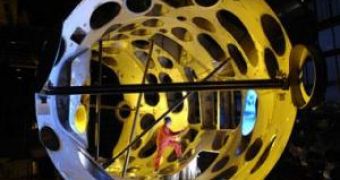The first phase of the build of the world's largest nuclear fusion reactor experiment, Wendelstein 7-X, has been completed with the installation of the first two half-modules, thus achieving 20 percent of the assembly of the inner core. All essential components of the reactor are ready for assembly, but even so, the project is scheduled for completion in no less than six years or so.
The designated location for the Wendelstein 7-X is at the Greifsward facility, ran by the Max Plank Institute of Plasma Physics. The goal of the project is to create a nuclear reactor, capable of burning hydrogen fuel through nuclear fusion reactions, such as those that take place in the Sun. By doing so, engineers would be able to further process into electric energy the massive amount of energy resulted in the reaction.
Nuclear fusion reactors process hydrogen by heating it up to temperatures high enough to reach a plasma state that can be then confined with the help of powerful magnetic fields. Upon the initiation of the fusion reaction, the core of the Wenderlstein 7-X reactor could reach temperatures of an excess of 100 million degrees Celsius. Wendelstein 7-X is the biggest stellarator type nuclear fusion reactor experiment ever built to investigate whether the concept of nuclear fusion on Earth is feasible.
Component elements
The core of the device consists of 50 superconducting magnet coils, 3.5 meter in hight, which will have the role to stabilize the reaction and to isolate it thermally from the surrounding medium. To bring the coils to a superconducting state, they will be cooled to temperatures close to absolute zero with the help of liquid helium, mostly for the advantage of lower energy consumption to sustain the powerful confining magnetic field.
Additionally, the magnetic system will be equipped with stellarator coils that also work in a superconducting state, to vary the magnetic field. While the stellarator coils have already been delivered by the contractor, the primary coils of the system are still in the manufacturing stage at Babcock Noell GmbH in W?rzburg and ASG Superconductors.
When completed, the coils will be insulated with an outer casing 16 meter in diameter, which will consist in a refrigerating system cooled with helium, with a power of 5000 watts, to bring the coils to a superconducting temperature. The core has 250 apertures with the role of providing the initial ignition of the fuel and for observing purposes.
First stage completed
The insulating system of the core consists in fiberglass-reinforced plastic superinsulating panels, coated with aluminum, kapton foil and glass fabric that helps to isolate the superconducting magnets against any thermal influence from the surrounding medium. On the 28th of February, the first stage of the build was completed with the assembly of the two half-modules of the core and the installation of four stellarator coils and two of the auxiliary coils that would help vary the magnetic field.
The secondary ring of the reactor is currently waiting for assembly. Once the two half-modules are brought together, the thermal isolation of the ring can be completed, coils attached and electrical connections wired to them, to complete the structural build. As soon as this phase of the build nears its end, the joints of the rings will be checked for leaks and electrically insulate against high voltage discharges that might take place. This is to take place about 25 weeks into the construction of the core.
Final assembly
With assembly finished, the rings will be lifted and transported to the experimentation hall, and placed on top of each other onto their actual foundation, Additionally, at the same time 60 of the ports of the core will be assembled to connect all plasma vessels with each other, and equipped with heavy thermal insulation as well.
During the final stages of the build, the plasma vessels will receive multiple other components such as the divertor, which will have the role of filtering out any impurities, and prevent thermal energy from escaping from the reactor core.
Upon completion of all five rings, the reactor will be finally connected to the electric power and helium supply, only to conduct a final check of the system before experimentation may begin. Unlike previous nuclear fusion reactors that were heated with laser systems, the Wendelstein 7-X will benefit from a microwave system.

 14 DAY TRIAL //
14 DAY TRIAL //